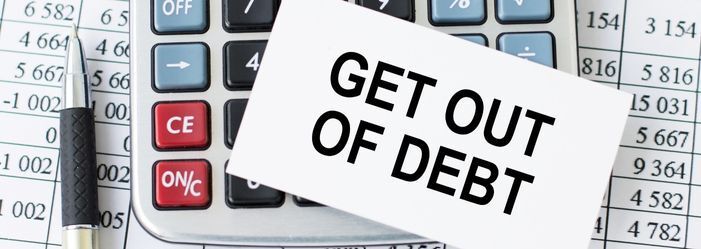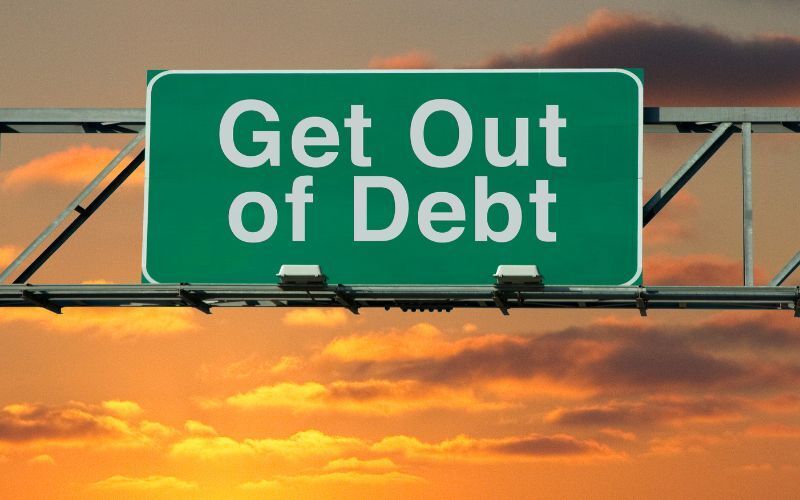Last Updated: October 03, 2023
Learn how to start reducing your debt

Working for a small paycheck is very difficult. Our entire culture is built on buying stuff and displaying your wealth through your belongings. It is very difficult to see people around you seemingly living a carefree life. Personal finance is also not taught by most parents or schools.
However, if you can learn to live within your means, budget, and cut costs, there is every possibility that you can stay out of debt or even get out of debt. And you can do it through determination and some sacrifice for a better future.
Getting into debt is easy, but getting out of debt can be extremely difficult.
Stop Taking on More Debt
dding to your debt load, especially with payday loans, using credit cards, and leaving the solutions for tomorrow is just a way to get yourself into a serious financial situation. In order to stop taking on debt, you need to understand where all your money is going.
Write Down All Your Debt
Gather together all the information about your debts. This includes who you owe them to, how much, the interest rates, the due dates, etc.
While you getting that data, go to www.annualcreditreport.com and get copies of your credit reports. Go over it for forgotten debts or errors.
For more information about credit reports, check out this article.
Create a Monthly Budget
If you do not understand where your money is going, you can not get your spending under control and pay off debt. There are many styles of budgets, and one will work for you. There are also free budgeting apps that can keep you up-to-date on all your spending.
- Track your spending for at least a month, including all recurring monthly payments. Count every penny you spend.
- Write down all your expenses and categorize them
- Look for hidden debts like streaming services
Now subtract your spending from your income. If you are like most of us, your income will be less than your expenditures. Look over your expenses for places to cut. Prioritize your needs.
Needs are the things you must have to survive. Housing, food, clothing, and medical care are some of your needs. Break those out of your budget and see if your income covers them. If it does not, it is time to see what you can do to make extra money, like a part-time job.
The other option is to change your housing, find cheaper car payments or transportation options, buy clothing at second-hand stores, and other drastic actions.
Budgeting Apps/Tools:
Budgeting apps and tools can provide extra accountability and visibility into your spending habits. Apps like Mint, YNAB, EveryDollar, and others connect to your bank accounts to automatically track where your money is going.
You can categorize expenses, set budgets for each category, and receive alerts when you go over budget. Consider using one of these free apps to monitor your daily spending and help stick to your debt payoff budget.
Cut Monthly Expenses
Look for places where you can eliminate spending. For instance, if you have three streaming services, cut out two. If you get a coffee every morning, make coffee at home for 4 days and buy coffee once a week.
Will this suddenly improve your situation? No. But it will help ease the stress on your finances and help you get out of debt.
Recheck your budget. Will everything fit? If yes, it is time to focus on your bills and getting out of debt. If not, keep working on it. You are on your way to being debt free.
Here are some suggestions to help you save money
- Buy food in bulk (as long as you will actually eat it!), especially when it’s on sale
- Clip coupons for food, clothes, toiletries, etc
- Sell your car (if this is realistic) and walk or bike to work
- Refinance mortgage payments
- Refinance car loans
- Cook at home, eat out less
- Cut subscriptions for cable, and gym memberships and look for cheaper cell phones and internet service
- Buy used if possible
Start Your Emergency Fund
o now that you have cut your budget to bare bones, we recommend starting an emergency fund. This is separate savings account that you use for emergencies. Start small - $100 as a goal, then build to $1000, then eventually three to six months of living expenses. If possible, try to keep this money in a high-yield savings account.
You are not going to build this really quickly, but a couple of dollars a month will build up. add more if you can afford to.
Use this money for emergencies instead of your credit card. An emergency is anything that threatens your ability to have food, shelter, or transportation.
What is not an emergency? A great sale on game systems, new clothes, and any impulse purchases. You can also use this fund to save up for large purchases, medical bills, or annual expenses.
Read this article for more information on building an emergency fund.
Earn More Money
If you are not already working three jobs at minimum wage, you may need to add another job temporarily. If you can get additional training, you may be able to move up to a higher pay scale.
More realistically, you may want to sell anything extra that is hanging in your closet or cluttering up your living space. Divide that money between your emergency fund and debt reduction.
Extra Income Sources:
Finding a side hustle or part-time work is a great way to bring in extra income you can use towards debt payments. Options like rideshare driving, online tutoring, freelance writing, participating in focus groups, or selling unused items could potentially generate an extra $100-200+ a month. Even a small amount of extra income can make a difference when you're on a limited budget.
The key is being very strategic with any extra money you have. Put it straight towards debt payments. With focus and sacrifice for a period of time, you can make progress and work your way out of debt! Setting clear payoff goals and sticking to them is critical. As Karen shared in her debt payoff story, "Having a plan helped me stay focused. I knew exactly how much I needed to put towards those credit cards each month to hit my target." You can also find tips on living debt-free and achieving financial freedom.
Now let's move on to how to pay off debt.
Debt Relief Options
The article " The Best Tricks to Paying Off Credit Cards " discusses how to eliminate credit card debt in great detail. We will hit the highlights on ways to pay off debt. There are five different strategies to pay off debt. These debt reduction techniques include debt avalanche, debt snowball, balance transfer credit card, debt consolidation loan, and debt settlement.
All of these are discussed with the expectation that you are not adding new debt and that you can make more than just minimum payments on each debt.
The Debt Avalanche Method
In the debt avalanche method, you first pay off debt with the smallest balance. Once that debt is paid off, all that minimum payment is added to the next smallest debt.
The Debt Snowball Method
In the debt snowball method, you focus on paying off the higher-interest debt first while making minimum payments on other debts. Once that one is paid off, you focus on the second-highest interest rate.
If you run your debts through an online debt snowball/avalanche payoff comparison calculator, you see that there's no one advantage to one versus the other in terms of paying off debt faster.
The biggest difference is which will make you feel most successful on your road to debt freedom. You can always switch between the methods to free up cash to pay down the higher interest rate after paying down the smaller debt.
The next two strategies involve reorganizing your debt.
Balance Transfer Credit Cards
This requires you to qualify for lower interest rates or zero-interest balance transfer credit cards. You then pay off your credit card debt and focus on paying off the balance transfer card.
This requires that you be able to:
- qualify for a credit card with a lower interest rate
- pay off the balance transfer credit card within the zero interest period
When deciding on finding a balance transfer card, understand any balance transfer fee schedule and the post-introductory interest rates. You may not be able to transfer a very large balance, but small multiple credit card balances may be an option.
Debt Consolidation Loans
A debt consolidation loan means you find a lower interest rate loan, like a personal loan or home equity loan. You then pay off multiple debts (consolidate debt)and focus on paying off the loan until you are debt free. Remember, there are fees associated with applying for a loan.
This requires that you be able to:
- qualify for a personal loan that has a lower interest
- monthly payments are lower than what you currently owe
- have a good credit score in order to get the best personal loans
Home equity loans often have low interest, but failure to repay this debt consolidation loan can result in foreclosure. Debt consolidation with a personal loan or balance transfer credit card can potentially save you money on interest charges. However, be sure to do your research before choosing a product. Compare interest rates, fees, terms, and other fine print. Avoid products with high fees or that encourage extended payment terms, as these often cost you more in the long run.
Debt Settlement
The final option is debt settlement. This method is for people who are in such debt that they are considering bankruptcy. In debt settlement, you stop paying unsecured bills while building up a savings account.
The debt settlement company negotiates with each creditor, and as the creditor settles, is paid off. The length of time depends on how much debt you have enrolled.
This method has two major drawbacks. First, it may damage your credit scores. Second, the IRS may view settled debt as income, and you may end up with a substantial tax bill.
If it seems like your best option, give the debt negotiators at Pacific Debt Relief a call.
Other Actions to Add to Debt Pay-Off Strategies
There are a few other actions that may help. Contact the credit card issuer to request a lowered interest rate
- Ask that due dates be changed to match your paydays
- Divide debt payments into four and pay weekly instead of monthly
- Apply most or all of any windfalls toward your debt and emergency fund
- Find a support system - this is someone who will encourage you not to spend money, to budget, and to stick without a payment plan
- Write down your goals and post them somewhere you can see them
-
FAQs
Our Conclusion
A low income and high expenses are together a recipe for disaster. Unfortunately, this is the reality for many people living in the US. The suggestions we have laid out are ways to help control your spending and pay off your debt - the two most important actions that can help your financial future.
You may benefit from a visit with a certified nonprofit credit counseling agency that can help you with your personal finances, budgeting, and a debt management plan.
If you can not make minimum debt payments and are considering bankruptcy, give us a call. We may be able to help you avoid a financial crisis, and we specialize in credit card debt. If we can not, we will refer you to the appropriate debt relief company.
✔ Accredited by Better Business Bureau with BBB A+ rating (4.93 rating and 1678 reviews)
✔ US News and World Reports and Bankrate ranked Pacific Debt Relief as one of “The Best Debt Relief Companies of 2024”
✔ 6.9 star rating by BestCompany.com (over 2379 client reviews)
✔ 4.8 star rating by TrustPilot based (over 1613 verified consumer reviews)
✔ ConsumerAffairs.com Accredited (over 544 verified reviews with an average rating of 5 stars)
✔ A Top 10 Rated Compan by TopTenReviews.com , ConsumersAdvocate.com and Top10debtconsolidation.com
✔ 4.6 star rating by Google (229 client reviews)
✔ 100% rating by SuperMoney (9 client reviews)
Reduce Your Credit Card Debt By Up to Half

BBB Reviews | 4.9/5.0 Rating









 Do Not Sell My Personal Information
Do Not Sell My Personal Information